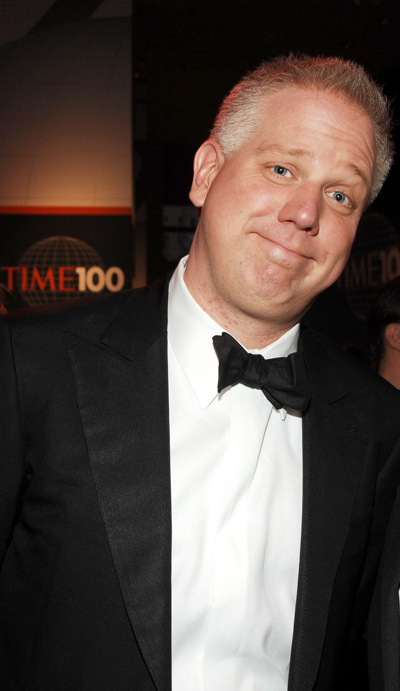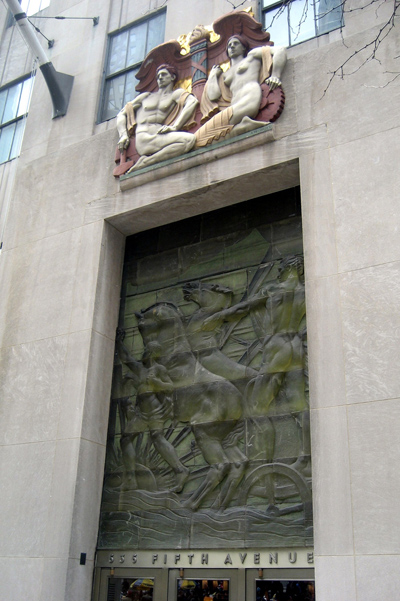To the dismay of survivalists everywhere, Glenn Beck announced last week that his screechy, preachy Fox news show would close up shop before the end of the year. Though Beck's eponymous television program averages over two million viewers each weekday, his ongoing disputes with Fox and widely reported tendency to scare away advertisers are rumored to have led to his exit.

This is Glenn Beck's "I'm thinking really hard about art" face. / © Patrcik McMullan Company
This is Glenn Beck's "I'm thinking really hard about art" face.
As we look back on the wild ride that has been the Glenn Beck show, we are trying not to obsess too much about his manic claim that the Obama administration is a hotbed of anti-Semitism or his theory that only hookers use Planned Parenthood. For those of us here at ARTINFO, those things are simply distractions from Beck's enduring legacy as an art critic.
Like any good critic -- formalist, Marxist, feminist, structuralist, and so on -- Beck chooses one specific lens through which to analyze art. This unlikely but crusading art scholar has fought tirelessly to uncover the hidden communist and otherwise dangerously propagandistic messages in America's artwork -- heroically oblivious to whether or not such messages actually exist. So, before Beck takes his final bow as Fox host, ARTINFO decided to take a walk down memory lane and reprise the top four moments in Beck art criticism.
1. The Great Christmas Ornament-Gate of '09, and '11
Beck used his formal analysis skills to uncover a shocking fact: an ornament on the official White House Christmas tree actually contained a coded admission of President Obama's communist sympathies. The offending ornament, originally hung during the winter of 2009, pictured a copy of Andy Warhol's famous silkscreen "Mao." According to Beck, the communist leader's presence on the tree was a secret little wink at all his comrades over there in China. (One can only imagine Beck's fantasy of Obama, frantically pacing the Oval Office in a Mao suit, muttering to himself, "If I can't prevent Christmas from coming, I must personally pick out each and every ornament on my Christmas tree! Then I will use them all to show my brethren what I really believe!") In reality, the little Mao was probably sent by one of the hundreds of community groups that contribute ornaments to the White House every year. But that didn't stop Beck from digging up the controversy again in January of this year, when he used it as background for his claim that Chinese pianist Lang Lang's state dinner performance subtly insulted America. (Lang performed a patriotic Chinese anthem in honor of Chinese President Hu Jintao.) While Beck shows a clear mastery of Marxist symbolism, we're surprised he didn't dwell longer on the real scandal of the Obama Christmas tree: Everyone knows that Obama is a Muslim.
2. The Washington Monument, the Great Symbol of Race Relations
At August's massive "Restoring Honor" rally in Washington, Glenn Beck revealed himself to be not only a canny art critic, but also something of an architectural historian. The rally, fronted by Beck and timed to coincide with the anniversary of Martin Luther King's famous "I Have a Dream" speech, aimed to invigorate the Tea Party movement. But Beck, ever the educator, also offered participants a bit of architectural history free of charge. Standing in front of the Washington Monument, Beck pointed out the "scar" on the obelisk, which, he said, marked where construction was halted during the Civil War. (According to L.A. Times critic Christopher Knight, "the apparent implication was that Sunday's rally would perform the necessary plastic surgery on race-related social divisions splitting the country.") But as Knight points out, the project was actually halted due to infighting among activist Catholic groups, who briefly took control of the project. After they stepped aside, their shoddy work had to be removed, leading to the "scar" on the monument.
3. The Great NEA Propaganda Controversy
In 2009, Beck became one of the central whistleblowers in what he dubbed the "NEA propaganda controversy," a campaign attacking the NEA for its alleged clandestine political activism. (Look at that: institutional critique! Is there anything the man can't do?) The attack, pushed by since-discredited conservative attack dog Andrew Breitbart, hit the big time with a segment on Beck's show about a particular NEA-led conference call. The purpose of the call was to encourage artists to participate in a DIY service project led by the First Lady called "United We Serve." In the segment, Beck accused NEA communications director Yosi Sergant of exhorting participating artists to create lefty propaganda. The controversy ultimately led to Sergant's firing from his position as communications director. And this wasn't Beck's only attack on the NEA: the pundit was also publicly enraged when the organization gave a grant to the San Francisco International LBGT Film Festival. If you're Glenn Beck, art criticism is no idle pastime -- sometimes people get hurt. Or fired.

Attilio Piccirilli's "Youth Leading Industry" at 636 Fifth Avenue
/ Photo by Wally Gobetz, courtesy Flickr
4. Rockefeller Center, Site of Great Communist Propaganda
Beck's attack of the murals at Rockefeller Center is perhaps his best-known foray into art criticism. Back in 2009 (which seems to be the golden year for Beck's critique), the firebrand woke up one morning and realized that the 75-year-old art at NBC's headquarters was filled with fascist and communist imagery. That 1937 door frame with an image of wheat and a man holding a hammer (which, now that you mention it, looks more like a shovel)? Clear communist propaganda! What about that 1936 bas-relief at 636 Fifth Avenue, with its evil, evil horses, dirty, dirty wheel, and big ol' rays of sunlight? An obvious reference to Mussolini. Beck's analysis, delivered in a blistering on camera lecture, led step by step to the inevitable conclusion that capitalist extraordinaire John D. Rockefeller, the founder of Standard Oil, was a closet communist. Never mind that it was actually John's son, Nelson Rockefeller, who commissioned the artwork, or that muralist Diego Rivera was barred from finishing a project for the family because he included an image of Lenin in one of his murals. (That particular offending fresco was destroyed, by the way.) All these facts are irrelevant to Beck's conclusion that "propaganda" is always hidden "in plain sight." The brouhaha actually inspired New York magazine critic Jerry Saltz to challenge Beck to curate an exhibition of his favorite artwork, though nothing ever came of it. Too bad -- because, based on the footage of Beck's radio broadcasts from his house, he has a taste for... paintings of tumbling dunce caps?
If viewers are lucky, there might be more where this came from. According to reports, Beck is contemplating starting his very own channel. The miniseries "Red Really Is Scary: The Real Story Behind Our Nation's Favorite Pigment" may be only a few months away.
-Julia Halperin, ARTINFO
More of Today's News from ARTINFO:
A Muse, Exported: Diane von Furstenberg on Using Warhol and the Wrap Dress to Conquer China
West Coast and Beyond Cool: An Appreciation of John McCracken
Censored Algerian Artist Mustapha Benfodil on His Part in the Sharjah Biennial Controversy
Will the Queens Museum of Art's $65 Million Expansion Be a Blessing or a Curse?
Politics, Doubt, and Daskalopoulos at the Guggenheim Bilbao
Like what you see? Sign up for ARTINFO's daily newsletter to get the latest on the market, emerging artists, auctions, galleries, museums, and more.